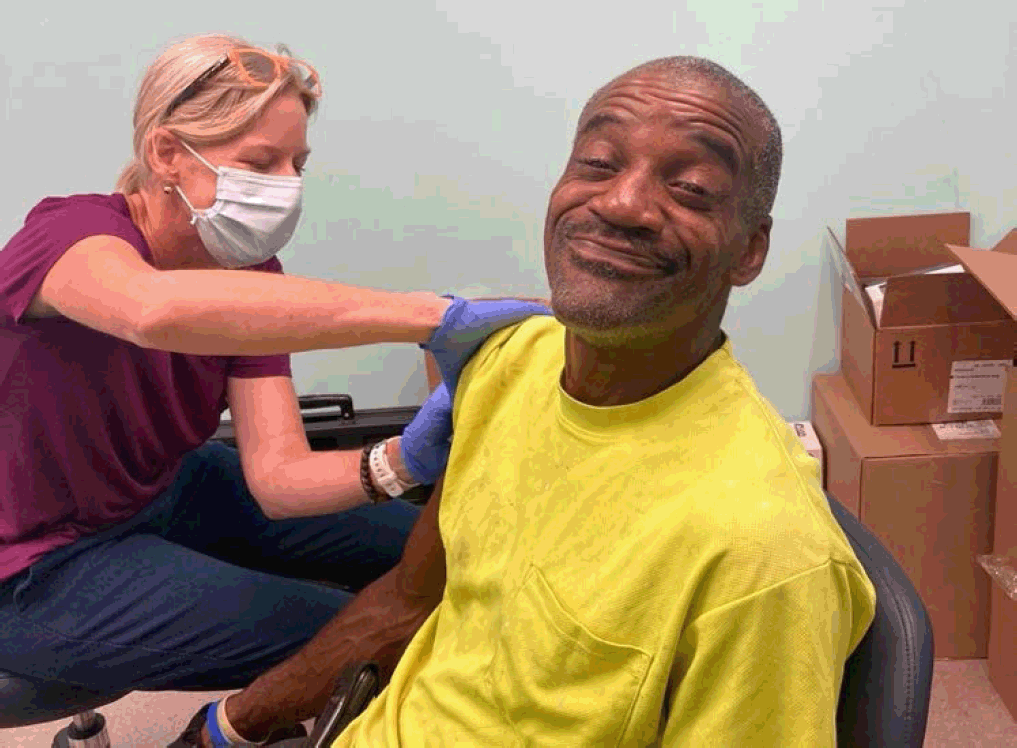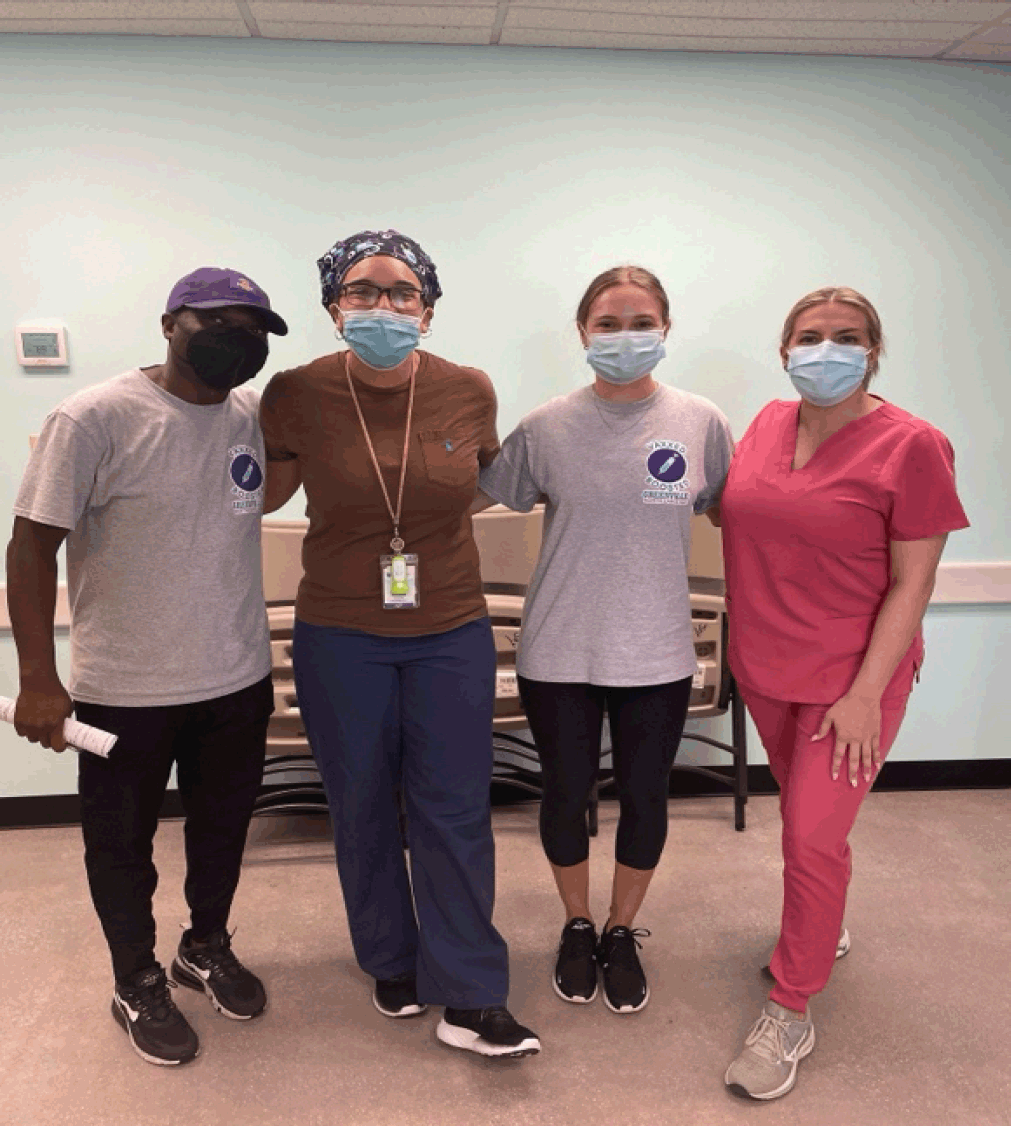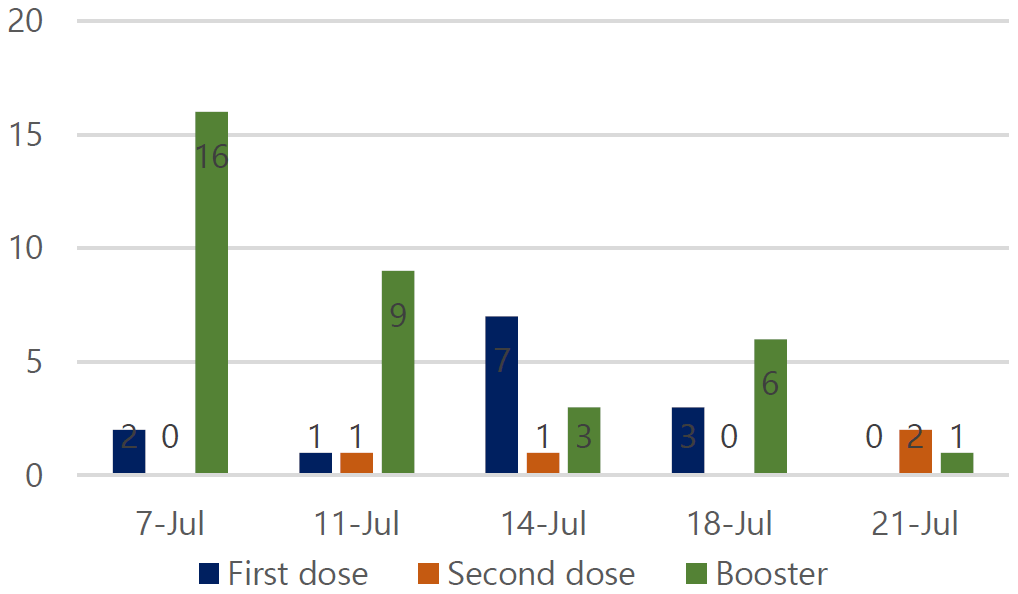Patient getting vaccinated at VAXXED & BOOSTED event

Taylor Stamey1, Oluwafemi Opelami2, Janet Moye3
doi: http://dx.doi.org/ijms.2024.2569
Volume 12, Number 3: 350-353
Received 18 02 2024; Rev-request 17 07 2024; Rev-recd 19 07 2024; Accepted 12 09 2024
VAXXED & BOOSTED was a COVID-19 vaccination community campaign held in July, 2022 in West Greenville, NC. Through the use of community ambassadors and hosting events at convenient locations and times, the program aimed to combat vaccine misinformation and alleviate barriers to receiving the vaccine in order to increase COVID-19 vaccination rates
Pitt County, North Carolina has an estimated vaccine hesitancy rate of 12.5%1. In the spring of 2022, Pitt County was ranked 48th out of the 100 counties in North Carolina for COVID vaccination rates, with only 53.8% of the population fully vaccinated2. West Greenville, located in Pitt County, is historically of lower socioeconomic status, which leads to poorer social determinants of health. Its residents face barriers to getting vaccinated such as transportation and getting time off of work. Additionally, misinformation and incorrect assumptions about the vaccine have been circulated throughout this community, as they have across the US.
In order to combat vaccine hesitancy and alleviate burdens preventing vaccination, a COVID-19 vaccination community campaign entitled VAXXED & BOOSTED was conducted during the summer of 2022. A similar campaign is the Sacramento County Vaccine Ambassador Program in California, which employed Vaccine Ambassadors to provide culturally relevant COVID-19 vaccine information3. They held vaccination events and used promotional methods such as phone banking, canvassing, and social media.
VAXXED & BOOSTED employed community ambassadors to educate people about the COVID-19 vaccine. Vaccination events were held at various times at two locations in West Greenville. Figure 1,2,3 show pictures of the events and people getting vaccinated. The goal of VAXXED & BOOSTED was to increase COVID-19 vaccination rates in West Greenville.
Figure 1.Patient getting vaccinated at VAXXED & BOOSTED event

Co-director Taylor receiving her booster at a VAXXED & BOOSTED event

Co-directors Taylor and Femi with two of the event vaccinators

One important aspect of the campaign was to have influential members of the community serve as ambassadors to promote the vaccine and vaccination events throughout the community. Community ambassadors consisted of non-medical people who grew up in and were familiar with the community, as well as trained community health workers. They spoke to people about the importance of getting vaccinated and resolve any hesitancies they had with the vaccine. They were trained with evidence-based talking points from the CDC's “Benefits of Getting Vaccinated” page and “Myths & Facts About COVID-19 Vaccines” page to combat vaccine hesitancy. These resources provide information about the safety of the vaccine and dispel myths surrounding the vaccine We also equipped our ambassadors with resources, such as flyers made from the information from these websites, to provide people. They were also compensated for their time.
Five events were hosted throughout West Greenville at the Community Crossroads Center and the JOY Soup Kitchen. The Community Crossroads Center is the homeless shelter located in West Greenville. The JOY Soup Kitchen is a free soup kitchen located in West Greenville. The purpose was to place vaccine clinics in convenient locations. Most events were hosted at noon, while one event was hosted at 6 pm in order to accommodate varying schedules. Events were promoted on the VAXXED & BOOSTED website, Facebook page, and Instagram. Free food was offered to all event attendees at the events hosted at the Community Crossroads Center, $10 gift cards and goodie bags were provided to those who got vaccinated, and educational resources were provided to event attendees to share with others. Pfizer COVID-19 vaccines were provided by the ECU Pharmacy and given by EMTs and nurse practitioners under the supervision of physicians. Funding was provided by the Community-Campus Partnerships for Health NNICE Grant.
A survey was implemented to gauge the efficacy of the event. Questions included in the survey were as follows: “Are you vaccinated for COVID? If yes, how many COVID vaccines have you received?” “Did you get vaccinated at today's event?” “Did the education provided at today's event influence your decision to get vaccinated?” “Did you learn something new at today's event?” “After today's event, do you plan to encourage others to get vaccinated?” “Did you find the use of community ambassadors helpful?” “Did you interact with a community ambassador before today's event?” Attendees circled “yes” or “no.”
Through VAXXED & BOOSTED, 52 people were vaccinated throughout 5 events that were held in a 1-month timespan. Of these 52 people, 13 people received their first dose of the vaccine, 4 people received their second, and 35 people received a booster Figure 4. The feedback that we received from participants was generally positive. Out of 29 people who completed the survey, 24 people found the use of the community ambassadors helpful (82.8%, p <0.001) and 15 people interacted with a community ambassador before the event they attended (51.7%, p=0.855). The education provided at the event influenced the decision of 22 people (75.9%, p=0.005), 24 people learned something new at the event (82.8%, p<0.001), and 27 people plan to encourage others to get vaccinated (93.1%, p<0.001).
Figure 4.Vaccinations Given Through VAXXED & BOOSTED

Only one non-medical community member was able to be utilized as a community ambassador; however, community health workers were able to fulfill this role. Though they may not have been members of the community, they were already embedded in this space from other community health work and were familiar to the community. This is likely the cause of the low interaction rate of participants with community ambassadors prior to the events, as they spend less time in the community than a community member would. Because only 52% of the 29 people who completed the survey interacted with a community ambassador or health worker before the event, word of mouth likely played a big role in promoting the events.
Because the majority of people learned something new at the event, stated the education at the event influenced their decision to get vaccinated, and planned to encourage others to get vaccinated the events seemed to be successful in fighting vaccine hesitancy. By hosting events at convenient locations and various time, the campaign alleviated barriers to getting vaccinated for those who were already planning to get vaccinated.
One weakness of this study is the low response rate to the survey. Every attendee was provided with a survey; however, as completing the survey was not a requirement to receiving the vaccine, many people did not respond. In addition, a few people asked for assistance with completing the survey due to poor literacy. People who asked for assistance were provided with it; however, we suspect that poor literacy rates in this community played a role in the low response rate. One in five adults in eastern North Carolina are illiterate, as opposed to one in seven in North Carolina as a whole4. Poor literacy rates likely also contribute to the poor vaccine rates in this community, as people are unable to verify information they hear from others. We tried to address this by providing our community ambassadors with talking points that can be explained verbally in simple language. In the future, it would likely be beneficial to conduct verbal surveys in this community.
Compared to the Sacramento Vaccine Ambassador Program, VAXXED & BOOSTED vaccinated people at a slower rate. The Sacramento Vaccine Ambassador Program has vaccinated over 300,000 people since June 2020, in a county with a population of 1,584,000. In contrast, VAXXED & BOOSTED vaccinated 52 people in July 2022 in Greenville, NC, which has a population of 89,233. Specific census data for West Greenville is not available, but it comprises a small portion of Greenville's population. Several factors likely contribute to the disparity in vaccination rates, including the scale of the campaigns and pre-existing community attitudes toward vaccines. Communities with more favorable perceptions of vaccines before the program are more likely to achieve higher vaccination rates. Additionally, demographic differences may play a role. In Greenville, 39.3% of the population is African American, compared to 7% in Sacramento County5,6. The historical mistrust of the healthcare system among African Americans, stemming from past unethical medical practices, could contribute to lower vaccination rates in predominantly Black communities.Many people mistrust governments and health systems; however, when lifesaving medical interventions such as the COVID-19 vaccine become available, it is important that they gain public support and trust. Public health experts warn that is very likely that we have another global pandemic as travel has become so readily available5. When this happens, communities need to be prepared to fight it immediately, and the public needs to be on board. It was a goal of the VAXXED & BOOSTED campaign to not only instill trust in the COVID-19 vaccine, but to also instill trust in the medical system, which will make it easier for others to get behind public health initiatives in the future.
Through VAXXED & BOOSTED, 52 people in the West Greenville community received their COVID-19 vaccine. It was determined that the use of community ambassadors and educational events in convenient locations was helpful in educating people about vaccine safety and efficacy, as well as increasing the vaccination rates in this area. Improvements that can be made in the future include implementing verbal exit surveys instead of written surveys and recruiting more community ambassadors to increase interaction rates prior to events. The campaign sought to fight vaccine misinformation, alleviate barriers to getting vaccinated, and instill trust in the medical community.
Arden Vessie
The Authors have no funding, financial relationships or conflicts of interest to disclose.
Conceptualization: TS, OO, JM. Data Curation: TS, OO. Funding Acquisition: JM. Project Administration: TS, OO, JM. Supervision: JM. Writing – Original Draft: TS. Writing – Review Editing: TS.
1. CDC Vaccine Hesitancy for COVID-19. Available online: https://data.cdc.gov/stories/s/Vaccine-Hesitancy-for-COVID-19/cnd2-a6zw/ (accessed on 3 December 2023).
2. WNCT “Latest: Highest COVID-19 vaccination rates in NC.”. Available online: https://www.wnct.com/news/north-carolina/latest-highest-covid-19-vaccination-rate-in-nc/ (accessed on 3 December 2023).
3. Public Health Launches Vaccine Ambassador Program. Available online: https://www.saccounty.gov/news/latest-news/Pages/Public-Health-Launches-Vaccine-Ambassador-Program.aspx (accessed on 18 July 2024).
4. WNCT “Addressing the illiteracy rate in eastern North Carolina”. Available online: https://www.wnct.com/news/addressing-the-illiteracy-rate-in-eastern-north-carolina/ (accessed on 18 July 2024).
5. U.S. Census Bureau. “QuickFacts: Greenville city, North Carolina.”. Available online: https://www.census.gov/quickfacts/fact/map/greenvillecitynorthcarolina/PST045219 (accessed on 18 July 2024).
6. U.S. Census Bureau. “QuickFacts: Sacramento County, California.”. Available online: https://www.census.gov/quickfacts/fact/table/sacramentocountycalifornia,US/PST045222 (accessed on 18 July 2024).
7. CEPI “How prepared are we to face a future pandemic?”. Available online: https://cepi.net/news_cepi/how-prepared-are-we-to-face-a-future-pandemic/ (accessed on 3 December 2023).
Taylor Stamey, 1 MOP, BA.4th year medical student. East Carolina University Brody School of Medicine, Greenville, NC, USA.
Oluwafemi Opelami, 2 BS. 4th year medical student. East Carolina University Brody School of Medicine, Greenville, NC, USA.
Janet Moye, 3 PhD, RN. Greenville, NC, US.
About the Author: Taylor Stamey is a 4th year medical student at a 4-year MD program at East Carolina University Brody School of Medicine. She is a Service Learning Distinction Track Scholar, for which she co-directed the VAXXED & BOOSTED campaign.
Correspondence: Taylor Stamey. Address: 600 Moye Blvd, Greenville, NC 27834, United States. Email: stameyt21@students.ecu.edu
Cite as Stamey T, Opelami o, Moye J. VAXXED & BOOSTED: Increasing COVID-19 Vaccination Rates in West Greenville, NC, USA. Int J Med Stud. 2024 Jul-Sep;12(3):350-353.
Copyright © 2024 Taylor Stamey, Oluwafemi Opelami, Janet Moye
This work is licensed under a Creative Commons Attribution 4.0 International License.
International Journal of Medical Students, VOLUME 12, NUMBER 3, September 2024